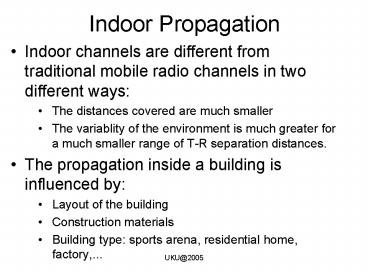Indoor Propagation
1 / 13
Title: Indoor Propagation
1
Indoor Propagation
- Indoor channels are different from traditional
mobile radio channels in two different ways - The distances covered are much smaller
- The variablity of the environment is much greater
for a much smaller range of T-R separation
distances. - The propagation inside a building is influenced
by - Layout of the building
- Construction materials
- Building type sports arena, residential home,
factory,...
2
Indoor Propagation
- Indoor propagation is domited by the same
mechanisms as outdoor reflection, scattering,
diffraction. - However, conditions are much more variable
- Doors/windows open or not
- The mounting place of antenna desk, ceiling,
etc. - The level of floors
- Indoor channels are classified as
- Line-of-sight (LOS)
- Obstructed (OBS) with varying degrees of clutter.
3
Indoor Propagation
- Buiding types
- Residential homes in suburban areas
- Residential homes in urban areas
- Traditional office buildings with fixed walls
(hard partitions) - Open plan buildings with movable wall panels
(soft partitions) - Factory buildings
- Grocery stores
- Retail stores
- Sport arenas
4
Indoor propagation events and parameters
- Temporal fading for fixed and moving terminals
- Motion of people inside building causes Ricean
Fading for the stationary receivers - Portable receivers experience in general
- Rayleigh fading for OBS propagation paths
- Ricean fading for LOS paths.
- Multipath Delay Spread
- Buildings with fewer metals and hard-partitions
typically have small rms delay spreads 30-60ns. - Can support data rates excess of several Mbps
without equalization - Larger buildings with great amount of metal and
open aisles may have rms delay spreads as large
as 300ns. - Can not support data rates more than a few
hundred Kbps without equalization. - Path Loss
- The following formula that we have seen earlier
also describes the indoor path loss - PL(d)dBm PL(d0) 10nlog(d/d0) Xs
- n and s depend on the type of the building
- Smaller value for s indicates the accuracy of the
path loss model.
5
Path Loss Exponent and Standard Deviation
Measured for Different Buildings
6
In building path loss factors
- Partition losses (same floor)
- Partition losses between floors
- Signal Penetration into Buildings
7
Partition Losses
- There are two kind of partition at the same
floor - Hard partions the walls of the rooms
- Soft partitions moveable partitions that does
not span to the ceiling - The path loss depends on the type of the
partitions
8
Partition Losses
Average signal loss measurements reported by
various researches for radio paths obscructed by
some common building material.
9
Partition Losses between Floors
- The losses between floors of a building are
determined by - External dimensions and materials of the building
- Type of construction used to create floors
- External surroundings
- Number of windows
- Presence of tinting on windows
10
Partition Losses between Floors
Average Floor Attenuation Factor in dB for One,
Two, Three and Four Floors in Two Office Buildings
11
Signal Penetration Into Buildings
- RF signals can penetrate from outside transmitter
to the inside of buildings - However the siganls are attenuated
- The path loss during penetration has been found
to be a function of - Frequency of the signal
- The height of the building
12
Signal Penetration Into Buildings
- Effect of Frequency
- Penetration loss decreases with increasing
frequency - Effect of Height
- Penetration loss decreases with the height of the
building up-to some certain height - At lower heights, the urban clutter induces
greater attenuation - and then it increases
- Shadowing affects of adjascent buildings
13
Conclusion
- More work needs to be done to understand the
characteristics of wireless channels - 3D numerical modeling approaches exist
- To achieve PCS, new and novel ways of classifying
wireless environments will be needed that are
both widely encompassing and reasonably compact.































